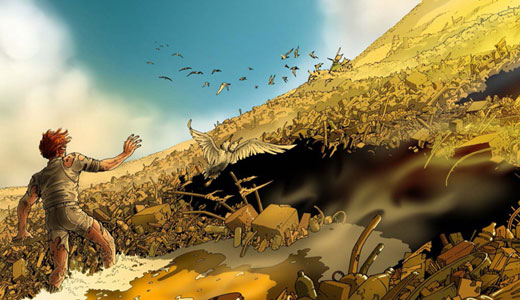
The Pacific Garbage Patch is an area of the Northern Pacific Ocean filled with tons of plastic trash, which has increased exponentially over the course of 40+ years. In a rare example of a comic series highlighting an environmental issue, Great Pacific will see its protagonist exploring and settling on a much larger, fictionalized version of the patch, declaring it an independent nation.
Great Pacific, written by DC Comics writer Joe Harris with art by Martin Morazzo, is an upcoming ecological science fiction series, to be released by Image Comics. In it, a bigger, dirtier version of the real-life Pacific Garbage Patch becomes a sovereign nation, claimed by lead character Chas Worthington.
Worthington is initially the heir to a large American oil fortune. He soon ditches his pursuit of wealth and power, however – opting instead for an apparently strong environmental concern. What creates his sudden ideological shift (from pro-oil to pro-environment) is not yet clear. As he settles on the patch, he comes to battle mutated marine life, deal with hostile island natives, and cope with threats posed by the U.S. Navy.
The series is described as documenting the fight against ecological catastrophe and clashes for resources, territories, and power. Judging by the synopsis, one could certainly believe that this will be a series on the correct side of the environmental argument. It also seems to make a nervy statement about the corruption of Big Oil. This is a story that, if taken in the appropriate direction, could come to carry much progressive weight.
What’s important outside of the sci-fi comic world, however, is realizing that the Pacific Garbage Patch is still just that – a patch; not a potential nation.
Marine biologist Miriam Goldstein said that the actual patch is nowhere as big as comics like Great Pacific would make it seem, but is nonetheless a highly severe problem that is only getting worse.
“Most pieces of garbage in the Pacific are about the size of your pinkie fingernail,” she remarked, though she added that she and her team have found much larger bits of trash floating along as well. But it isn’t the size that’s alarming, she explained; it’s the sheer amount of litter that makes it such a dire issue.
Perhaps more dire is what that garbage does to wildlife. Birds and fish mistake discarded plastic for food and consume it. Resultantly, they slowly starve to death. Others get caught in the plastic and, likewise, die. Though research on the subject is not entirely conclusive, said Goldstein, still, “Some studies of albatrosses show plastic correlating with poor nutrition – and you [also] see a lot of dead chicks with their stomachs absolutely stuffed with plastic.”
There is also worrying potential for ocean pollution to throw the ecosystem out of balance, because certain creatures, like water skater insects, crabs, and barnacles, are thriving in the litter-plagued environment. Thus, these creatures are competing with the locals for more food, and that may push many fish and birds out of the area.
Great Pacific will prove to be most handy and informative. It arrives at a vital period, in which, amidst the firings of top ocean scientists and right-wing efforts to dismantle anti-pollution regulations, the problems with waters around the world are getting worse. This upcoming series will depict a different kind of hero, fighting a different kind of villain: pollution; and, if Mr. Harris is so brave as to broach the subject, Big Oil.
“If trends continue,” said Goldstein, “we’re going to see more plastic than fish. And with that plastic will come more invasive species and more water skaters. The danger is that this could alter the open ocean forever, and destroy all the native life there that has kept them healthy for thousands of years.”
Photo: Chas Worthington stands upon the Pacific Garbage Patch in “Great Pacific.” Joe Harris.net










